
|

|

|
|
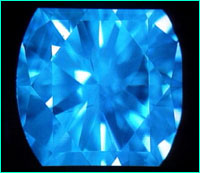 What lies behind the dazzling dance of light in a
diamond? Read on.
What lies behind the dazzling dance of light in a
diamond? Read on.
|
The Science Behind the Sparkle
by Robert Hazen
Today, most people admire diamonds for two exceptional
attributes: their hardness and their brilliance. Scholars knew
of diamonds' unrivaled hardness since antiquity, but its
unique optical properties went unrecognized until
comparatively recently. The natural diamonds that were hoarded
by potentates of old have little of the visual drama that we
associate with today's faceted gems. Deeply colored rubies,
emeralds, and sapphires were far more prized as adornments.
Owners accumulated the seemingly indestructible diamond
pebbles, as found in their unpolished natural state, as
talismans against defeat and symbols of their own "manly"
virtues, without ever seeing diamonds as objects of beauty.
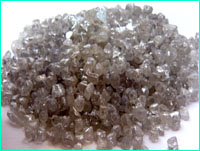 In the 1700s, gold miners in Brazil tossed aside a
fortune in unrecognized raw diamonds.
In the 1700s, gold miners in Brazil tossed aside a
fortune in unrecognized raw diamonds.
|
|
When unearthed, most diamonds appear roughly rounded with
perhaps a hint of regular crystal form. Many are colorless,
but most are pale shades of yellow; red, orange, green, blue,
brown, and even black diamonds are also found. Raw, uncut
stones lack the exuberance of jewelry-store gems and can
appear quite ordinary; Brazilian gold miners of the 18th
century cast aside a fortune in unrecognized diamonds while
panning for the precious metal. Diamond's familiar ornamental
role represents a relatively recent development - a
consequence in part of scientists' growing understanding of
the nature of light.
|
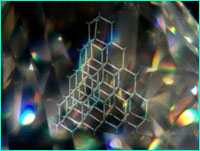 Diamond's tight crystalline structure, here shown
modeled against a diamond, slows light down like no
other substance on Earth.
Diamond's tight crystalline structure, here shown
modeled against a diamond, slows light down like no
other substance on Earth.
|
A few scientific ideas have become part of our folklore. The
equation E=mc2 is one - a
cultural icon as much as it is a statement of the equivalence
of mass and energy. Another of these commonplace science
snippets tells us that the speed of light is constant. A
T-shirt slogan popular in physics departments proclaims
"186,000 miles per second: It's not just a good idea, it's the
law!" But as for many other legal systems, there's some fine
print most people ignore. You have to add the rather mundane
words, "in a vacuum." When light travels through matter - air,
water, glass, or diamond, for example - it travels slower than
186,000 miles per second. The actual explanation, having to do
with the way light interacts with the electrons present in
every atom, is somewhat complex, but you can visualize this
slow-down by thinking of light rays having to make little
detours every time an electron gets in the way.
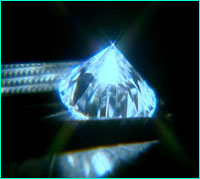 Light inside a diamond travels at less than half its
speed in a vacuum.
Light inside a diamond travels at less than half its
speed in a vacuum.
|
|
Most clear and colorless objects retard light only a modest
amount. The air we breathe has only a trifling
billion-trillion atoms per cubic inch. Space between atoms are
much greater than the size of the atoms themselves, so air
reduces light speed by just a few hundred miles per second -
not enough to notice under most circumstances. In water and
ice, which have thousands of times more atoms per cubic inch
than air, light travels about 140,000 miles per second - 30
percent slower than in a vacuum. Window glass drops light
speed to 120,000 miles per second, similar to the travel time
through most common minerals, whereas lead-containing
decorative glass, the kind used in chandeliers and cut glass,
slows light even more, to about 100,000 miles per second (lead
has lots of electrons that get in the way). Diamonds put the
brakes on light like no other known colorless substance.
Diamond is crammed with electrons - no substance you have ever
seen has atoms more densely packed - so light pokes along at
less than 80,000 miles per second. That's more than 100,000
miles per second slower than in air.
|
Light pokes along inside a diamond at less than 80,000
miles per second. That's more than 100,000 miles per
second slower than in air.
|
Most people never have reason to notice the variable speed of
light, but you experience one of its consequences every day.
Each time light passes from one clear substance into another
with a different light speed, the light rays have a tendency
to bend. You've probably noticed the distortion of people and
objects in a swimming pool, which occurs when light waves have
to change direction as they pick up speed coming out of the
water. Ripples on the pool's surface compound the angular
distortion. If you wear glasses or contact lenses, which
"correct" the way light bends into your eyes, you take
advantage of this useful optical phenomenon.
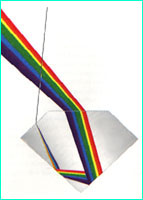 Light entering a diamond ricochets around until it
can find a way out, broken into its constituent
wavelengths.
Light entering a diamond ricochets around until it
can find a way out, broken into its constituent
wavelengths.
|
|
Light does not always bend when passing between different
materials. If light rays strike a clear substance head on or
at a modest angle - like the path of light coming through your
window - most of the rays will travel straight through without
bending. You can look down from a boat at the nearly
undistorted bottom of a calm, clear lake or pond because
sunlight enters the water from overhead and then comes back
through the transparent water almost vertically to your eyes.
But try as you might, you can't see the bottom of even the
clearest lake standing on the shore, because you are at too
low an angle to the water. Almost all of the light reaching
your eyes has been reflected off the water's surface. That's
why you can see the beautiful mirrored reflection of trees on
the opposite shore of a glassy lake early in the morning.
Diamond plays this reflecting trick better than any other
colorless substance. Light enters a faceted gemstone from all
sides, but it may bounce back and forth several times inside
before it finds a clean, straight shot out. All this changing
direction accomplishes something very dramatic, because
so-called white light actually contains all of the rainbow's
colors. Each color - red, orange, yellow, green, blue, and
violet - bends and reflects inside the diamond slightly
differently. The farther the light travels, the more the
colors separate, or "disperse." Bounce light inside a diamond
just two or three times and the colors disperse spectacularly.
Diamond-like substitutes, including "cubic zirconia," a
crystalline compound synthesized from the elements ziconium
and oxygen, attempt to mimic this light-dispersing property,
though they fall short of diamond's brilliance and unrivaled
hardness.
If you look closely at a faceted diamond, you can see that it
soaks up white light and breaks it apart like a prism,
dispersing it into a rainbow of colors. Diamonds sparkle and
dance with colored light; each of its dozens of facets
produces its own dazzling display. Other natural gemstones
disperse white light to some degree, but none comes close to
diamond's ability to reveal the rainbow.
Robert M. Hazen is a research scientist at the Carnegie
Institution of Washington's Geophysical Laboratory and
Robinson Professor of Earth Sciences at George Mason
University. This article was excerpted with permission from
Hazen's book,
The Diamond Makers: A Compelling Drama of Scientific
Discovery,
published by Cambridge University Press in 1999.
Photos: (1-4) ©BBC; (5) Reprinted with the permission
of Cambridge University Press.
The Science Behind the Sparkle
| Diamonds in the Sky
A Primer of Gemstones
|
See Inside a Diamond
Resources |
Transcript
| Site Map |
Diamond Deception Home
Editor's Picks
|
Previous Sites
|
Join Us/E-mail
|
TV/Web Schedule
About NOVA |
Teachers |
Site Map |
Shop |
Jobs |
Search |
To print
PBS Online |
NOVA Online |
WGBH
©
| Updated November 2000
|
|
|


 What lies behind the dazzling dance of light in a
diamond? Read on.
What lies behind the dazzling dance of light in a
diamond? Read on.
 In the 1700s, gold miners in Brazil tossed aside a
fortune in unrecognized raw diamonds.
In the 1700s, gold miners in Brazil tossed aside a
fortune in unrecognized raw diamonds.
 Diamond's tight crystalline structure, here shown
modeled against a diamond, slows light down like no
other substance on Earth.
Diamond's tight crystalline structure, here shown
modeled against a diamond, slows light down like no
other substance on Earth.
 Light inside a diamond travels at less than half its
speed in a vacuum.
Light inside a diamond travels at less than half its
speed in a vacuum.
 Light entering a diamond ricochets around until it
can find a way out, broken into its constituent
wavelengths.
Light entering a diamond ricochets around until it
can find a way out, broken into its constituent
wavelengths.